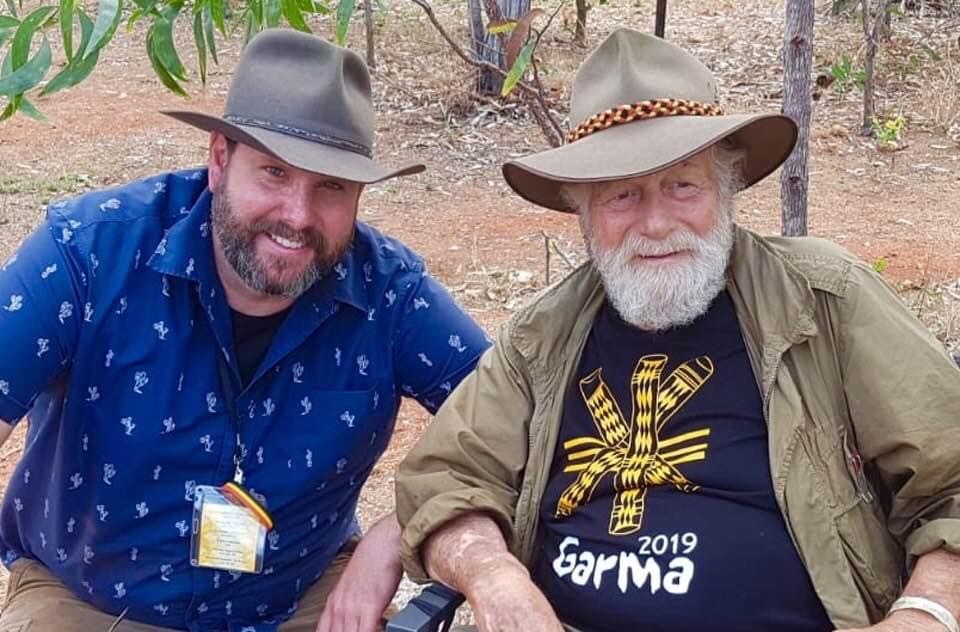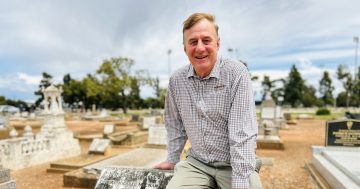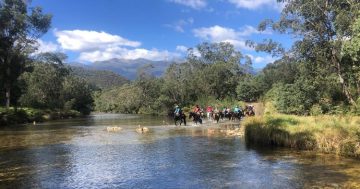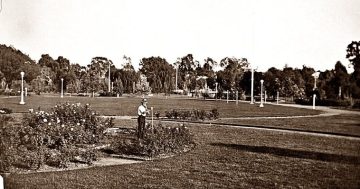
Thomas Michael McNamarra and wife Teresa (seated) with their family in 1913. Photo: Ancestry.
With winemaker Darren De Bortoli reigniting the debate over the true identity of Banjo Paterson’s Clancy of “The Overflow”, we’re taking a look at the man, the myth and the legend and the various claims to being the ‘real’ Clancy.
Was the character inspired by drover Thomas Michael McNamara who married in Wagga and is buried in Griffith? Was he the stockman and shearer Thomas Clancy, who hired Paterson as his solicitor and claimed that he was “the party” in the poem? Or is he both of these and more?
“Clancy of the Overflow” first appeared in the The Bulletin on 21 December 1889 and was subsequently syndicated widely and included in anthologies and AB Paterson’s collected works.
The poem contrasts life in the “dusty, dirty city” and Paterson’s “dingy little office” with his romanticised imaginings of the life of a drover who lives carefree in the open country and “sees the vision splendid of the sunlit plains extended”.
Clancy also makes a cameo in the Man From Snowy River as the veteran horseman who nobly stands by the young mountain rider who would emerge as the fearless hero of the tale.
“And Clancy of the Overflow came down to lend a hand, No better horseman ever held the reins; For never horse could throw him while the saddle girths would stand,
“He learnt to ride while droving on the plains.”
Jack Thompson famously portrayed Clancy in the 1982 film capturing perfectly the lovable, laconic bushman renowned for his horsemanship and carefree itinerant lifestyle.
Banjo Paterson himself shrugged off attempts to identify the heroes of his poems, but over the years there have been numerous bushmen who have claimed to be the “real” Clancy or the Man From Snowy River.

I have had the pleasure of meeting Jack “Clancy” Thompson on several occasions at the Garma Festival in Arnhem Land. Photo: Chris Roe.
Thomas Michael McNamara’s claim to be the man behind the legend is based on his recollections of an epic ride at Toole’s Creek southeast of Wagga Wagga.
The towering 6 foot 4 horseman had been a friend of Banjo’s father, the Scottish-born grazier Andrew Bogle Patterson who had a property at Illalong Creek.
In an interview with the Nambour Chronicle in March 1939, the 90-year-old McNamara identified his brother-in-law Jim Troy and his horse ‘Mungo’ as the inspiration for “The Man From Snowy River”.
“From Troy’s place, near Wagga you could see the hills in the direction of Tumut,” McNamarra recalled.
“Our adventure was not down Kosciusko’s side, as Paterson sang. ‘Banjo’ shifted the mountain into our country to make the tale poetic.”
According to McNamara, three horses, including a £1000 colt, had escaped from the Troys’ property and he and his cousin Andy McNamara joined Tom and Jim Troy to chase them down.
“When Jim joined us on little Mungo, long-bearded Tom, who sat on Yellow Clarence, laughed at Jim and his weedy animal,” McNamara said.
“Then I took Jim’s part. As Banjo truly says, ‘Only Clancy stood his friend’, and I added, ‘I think we ought to let him come.’
“We started after colts, up hill and through gullies, but the wild horses took fright as we approached. ‘You can say goodbye to the mob,’ yelled Tom Troy. But Jim and Mungo went on,” McNamara continued.
“Later Jim had the mob moving towards us. Tom told me to get on the next hill and wheel the mob to the right, but they beat us. Jim stuck to them and ran them, as the poem says, ‘single-handed till their sides were white with foam.'”
Jim Troy passed away at the age of 33 and is buried in Cootamundra, while McNamarra returned to the Riverina from Queensland in his final years and died in 1943 at age 94.
While McNamarra’s claim relies on his recollections of daring-do and links to the veteran rider depicted in The Man From Snowy River, his primary challenger pressed his connections to the shearer from The Overflow and the fact that he shares his name.
Thomas Gerald Clancy was an overseer and drover who worked on sheep stations on the Lachlan River in central NSW until the 1880s. He spent time working near Nyngan next to a property called The Overflow.
The family has evidence of a direct connection to Banjo as the signature of solicitor AB Paterson can still be seen on the will he drafted and witnessed for Thomas Clancy.
In an article published in the Melbourne Advocate in February 1910, Clancy replied to questions of a connection to the character in the poem, saying “I am supposed to be that party”.
He also offered up a poem of his own, delivering a droll reply to Paterson’s idyllic imaginings of the droving lifestyle.
“The Men at Overflow” is a much bleaker vision of ‘drought-scourged plains extended’ and dying stock around empty waterholes which he sarcastically counts “among the pleasures that town folks never know”.










